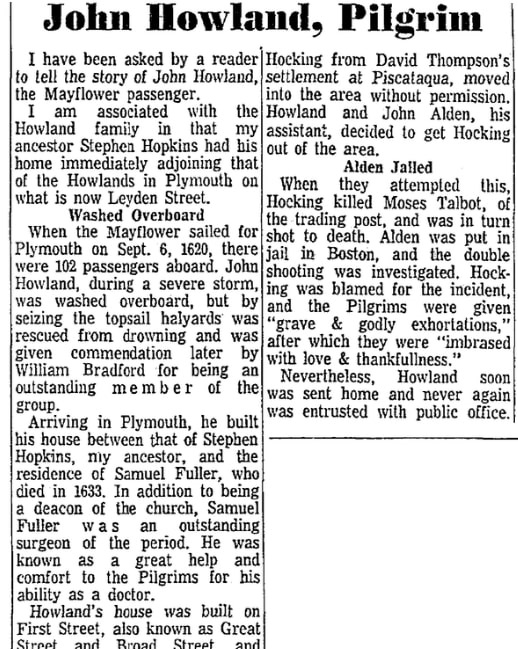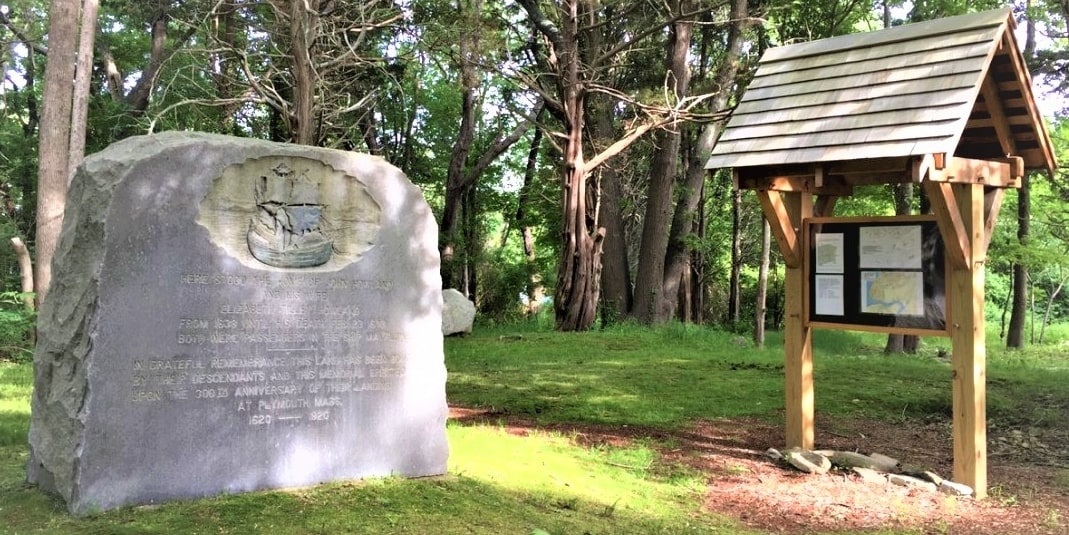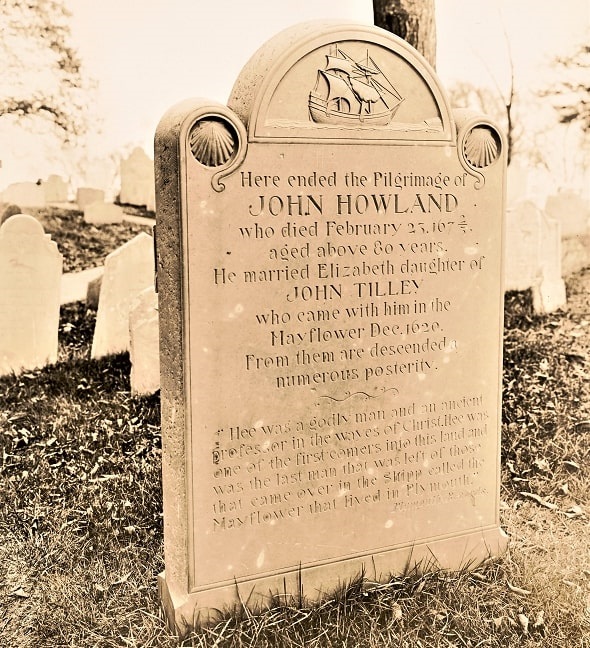Introduction: In this article, Melissa Davenport Berry continues her series on Mayflower descendants, focusing on author and historian Edward Rowe Snow writing about Pilgrim John Howland. Melissa is a genealogist who has a website, americana-archives.com, and a Facebook group, New England Family Genealogy and History.
Today I continue with my series “Mayflower Descendants: Who’s Who” with another Pilgrim story from Edward Rowe Snow (1902-1982), author and famous “Flying Santa.” Rowe is a descendant of Mayflower passenger Stephen Hopkins. Due to his Mayflower ancestor connection, coupled with his love for history, Snow published several newspaper articles chronicling Plymouth’s early colony.
Here is one from his column “Sea and Shore Gleanings” which ran in the Patriot Ledger, a Quincy, Massachusetts, newspaper. His subject: Pilgrim John Howland.

In this column, Snow wrote:
I have been asked by a reader to tell the story of John Howland, the Mayflower passenger.
I am associated with the Howland family in that my ancestor Stephen Hopkins had his home immediately adjoining that of the Howlands in Plymouth on what is now Leyden Street.
When the Mayflower sailed for Plymouth on Sept. 6, 1620, there were 102 passengers aboard. John Howland, during a severe storm, was washed overboard, but by seizing the topsail halyards was rescued from drowning and was given commendation later by William Bradford for being an outstanding member of the group.
Arriving in Plymouth, he built his house between that of Stephen Hopkins, my ancestor, and the residence of Samuel Fuller, who died in 1633. In addition to being a deacon of the church, Samuel Fuller was an outstanding surgeon of the period. He was known as a great help and comfort to the Pilgrims for his ability as a doctor.
Howland’s house was built on First Street, also known as Great Street and Broad Street, and changed to Leyden Street in 1823.
It is believed that John Howland witnessed the first execution in the Plymouth Colony. In 1630, after a bitter quarrel, John Billington, known as one of the “profanest families amongst them” who “shuffled” into the Pilgrim company in some peculiar way, according to Bradford, blew John Newcomen to pieces. Howland and others decided that Billington was guilty of “willful murder.” Billington was sentenced and duly hanged, drawn and quartered.
John Howland’s gravestone, erected by the Hon. John Howland, president of the Rhode Island Historical Society, and a fifth generation descendant, reads:
Here ended the Pilgrimage of JOHN HOWLAND and ELIZABETH his wife. She was the dau’tr of Gov. Carver. They arrived in the Mayflower Dec. 1620; they had 4 Sons & 6 dau’trs from whom are descended a numerous posterity. “1672 Feb’y 23d JOHN HOWLAND of Plymouth deceased, he lived to the age of 80 yr’s. He was the last man that was left of those that came over in the Ship called the Mayflower that lived in Plymouth.” (Plymouth Records)
It is recorded above that Mr. Howland married a daughter of Governor Carver, but Bradford, in his History, states that John Howland married Elizabeth, the daughter of John Tillie.
Mr. Howland was a distinguished man, and devoted to the interests of the colony, both in relation to its civil and religious institutions. He was deputy and assistant for several years. His early residence was on Summer Street, but afterwards he moved to Rocky Nook, where he died.

The colonial records say, “He was a Godly man and an ancient professor in the ways of Christ, and proved a useful instrument of good in his place.”
John Howland, as a servant of Governor Carver, went with a group in the Mayflower shallop from Provincetown to look over Plymouth Bay, and participated in a skirmish with Indians in which no one was injured. Later the group was nearly shipwrecked and finally landed on Clark’s Island in Plymouth Harbor.
In 1627 a monopoly on the colony’s trade was granted to Bradford, Allerton, and Standish, with the provision that they might choose whatever partners they wished.
John Howland was one, and he was put in charge of the trade for beaver, otter, and other furs with the Abnaki Indians at Augusta, Maine. Mr. Howland did well and the business prospered.
The only town touched by the witch hysteria on the South Shore was Scituate. One or two were tried, but the whole thing was quickly discouraged. The wife of William Holmes, Standish’s lieutenant, was tried on complaint of Dinah Sylvester, before John Howland as presiding magistrate. After questioning her carefully he fined her five pounds and had her whipped. That was the end of witchcraft in the colony.
When he was in charge of the Kennebec trading post, a Captain Hocking from David Thompson’s settlement at Piscataqua moved into the area without permission. Howland and John Alden, his assistant, decided to get Hocking out of the area.
When they attempted this, Hocking killed Moses Talbot, of the trading post, and was in turn shot to death. Alden was put in jail in Boston, and the double shooting was investigated. Hocking was blamed for the incident, and the Pilgrims were given “grave & godly exhortations,” after which they were “imbrased with love & thankfulness.”
Nevertheless, Howland soon was sent home and never again was entrusted with public office.
Just a note on the grave marker. The one mentioned in this article has since been replaced. You can read all about it at the Pilgrim John Howland Society site.

Elizabeth Tilley Howland has her own grave marker as well. For more on that visit “Four-part Cable TV series on Elizabeth Howland”
Explore over 330 years of newspapers and historical records in GenealogyBank. Discover your family story! Start a 7-Day Free Trial.
Note on the header image: Howland House Float in the 2019 parade, Duxbury, Massachusetts. Courtesy of the Pilgrim John Howard Society.
Related Articles:

Do you have more information about John Alden being put in jail in Boston? He is my husband’s Mayflower ancestor.
Hi Mary Ann, I believe I have come across something on early Alden family on that subject. I will send you an email. Thanks, Melissa